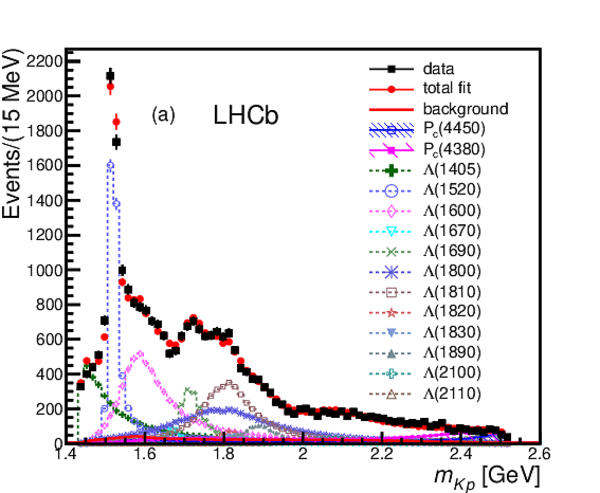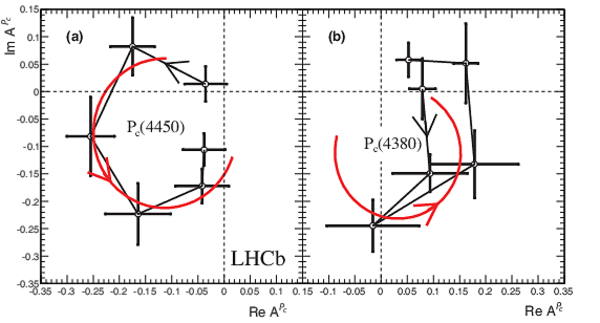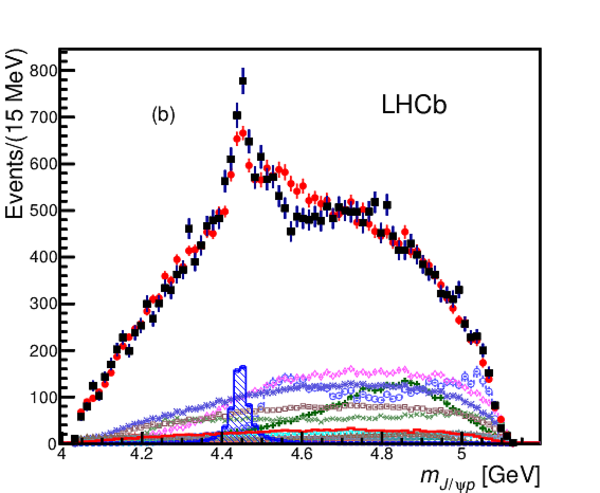Observation of $J/\psi p$ resonances consistent with pentaquark states in ${\Lambda_b^0\to J/\psi K^-p}$ decays
[to restricted-access page]Information
LHCb-PAPER-2015-029
CERN-PH-EP-2015-153
arXiv:1507.03414 [PDF]
(Submitted on 13 Jul 2015)
Phys. Rev. Lett. 115 (2015) 072001
Inspire 1382595
Tools
Abstract
Observations of exotic structures in the $J/\psi p$ channel, that we refer to as pentaquark-charmonium states, in $\Lambda_b^0\to J/\psi K^- p$ decays are presented. The data sample corresponds to an integrated luminosity of 3/fb acquired with the LHCb detector from 7 and 8 TeV pp collisions. An amplitude analysis is performed on the three-body final-state that reproduces the two-body mass and angular distributions. To obtain a satisfactory fit of the structures seen in the $J/\psi p$ mass spectrum, it is necessary to include two Breit-Wigner amplitudes that each describe a resonant state. The significance of each of these resonances is more than 9 standard deviations. One has a mass of $4380\pm 8\pm 29$ MeV and a width of $205\pm 18\pm 86$ MeV, while the second is narrower, with a mass of $4449.8\pm 1.7\pm 2.5$ MeV and a width of $39\pm 5\pm 19$ MeV. The preferred $J^P$ assignments are of opposite parity, with one state having spin 3/2 and the other 5/2.
Figures and captions
|
Feynman diagrams for (a) $\Lambda ^0_ b \rightarrow { J \mskip -3mu/\mskip -2mu\psi \mskip 2mu} \Lambda ^*$ and (b) $\Lambda ^0_ b \rightarrow P_c^+ K^-$ decay. |
Feynma[..].pdf [29 KiB] HiDef png [107 KiB] Thumbnail [104 KiB] *.C file |

|
|
Invariant mass of (a) $K^-p$ and (b) $ { J \mskip -3mu/\mskip -2mu\psi \mskip 2mu} p$ combinations from $\Lambda ^0_ b \rightarrow { J \mskip -3mu/\mskip -2mu\psi \mskip 2mu} K^-p$ decays. The solid (red) curve is the expectation from phase space. The background has been subtracted. |
mkp-phsp.pdf [36 KiB] HiDef png [217 KiB] Thumbnail [186 KiB] *.C file |

|
|
mjpsip[..].pdf [37 KiB] HiDef png [228 KiB] Thumbnail [198 KiB] *.C file |

|
|
|
Fit projections for (a) $m_{Kp}$ and (b) $m_{ { J \mskip -3mu/\mskip -2mu\psi \mskip 2mu} p}$ for the reduced $\Lambda ^*$ model with two $P_c^+$ states (see Table 1). The data are shown as solid (black) squares, while the solid (red) points show the results of the fit. The solid (red) histogram shows the background distribution. The (blue) open squares with the shaded histogram represent the $P_c(4450)^+$ state, and the shaded histogram topped with (purple) filled squares represents the $P_c(4380)^+$ state. Each $\Lambda ^*$ component is also shown. The error bars on the points showing the fit results are due to simulation statistics. |
mkp-de[..].pdf [56 KiB] HiDef png [443 KiB] Thumbnail [288 KiB] *.C file |

|
|
mjpsip[..].pdf [62 KiB] HiDef png [481 KiB] Thumbnail [247 KiB] *.C file |

|
|
|
Invariant mass spectrum of $ { J \mskip -3mu/\mskip -2mu\psi \mskip 2mu} K^-p$ combinations, with the total fit, signal and background components shown as solid (blue), solid (red) and dashed lines, respectively. |
fitmas[..].pdf [36 KiB] HiDef png [295 KiB] Thumbnail [185 KiB] *.C file |

|
|
Invariant mass squared of $K^-p$ versus $ { J \mskip -3mu/\mskip -2mu\psi \mskip 2mu} p$ for candidates within $\pm15$ MeV of the $\Lambda ^0_ b $ mass. |
dlz.pdf [108 KiB] HiDef png [915 KiB] Thumbnail [458 KiB] *.C file |

|
|
Results for (a) $m_{Kp}$ and (b) $m_{ { J \mskip -3mu/\mskip -2mu\psi \mskip 2mu} p}$ for the extended $\Lambda ^*$ model fit without $P_c^+$ states. The data are shown as (black) squares with error bars, while the (red) circles show the results of the fit. The error bars on the points showing the fit results are due to simulation statistics. |
mkp-ex[..].pdf [61 KiB] HiDef png [458 KiB] Thumbnail [290 KiB] *.C file |

|
|
mjpsip[..].pdf [67 KiB] HiDef png [503 KiB] Thumbnail [246 KiB] *.C file |

|
|
|
Various decay angular distributions for the fit with two $P_c^+$ states. The data are shown as (black) squares, while the (red) circles show the results of the fit. Each fit component is also shown. The angles are defined in the text. |
angles.pdf [88 KiB] HiDef png [841 KiB] Thumbnail [505 KiB] *.C file |

|
|
$m_{ { J \mskip -3mu/\mskip -2mu\psi \mskip 2mu} p}$ in various intervals of $m_{Kp}$ for the fit with two $P_c^+$ states: (a) $m_{Kp}<1.55$ GeV, (b) $1.55<m_{Kp}<1.70$ GeV, (c) $1.70<m_{Kp}<2.00$ GeV, and (d) $m_{Kp}>2.00$ GeV. The data are shown as (black) squares with error bars, while the (red) circles show the results of the fit. The blue and purple histograms show the two $P_c^+$ states. See Fig. 7 for the legend. |
mjpsip[..].pdf [87 KiB] HiDef png [948 KiB] Thumbnail [405 KiB] *.C file |

|
|
Fitted values of the real and imaginary parts of the amplitudes for the baseline ($3/2^-$, $5/2^+$) fit for a) the $P_c(4450)^+$ state and b) the $P_c(4380)^+$ state, each divided into six $m_{ { J \mskip -3mu/\mskip -2mu\psi \mskip 2mu} p}$ bins of equal width between $-\Gamma_0$ and $+\Gamma_0$ shown in the Argand diagrams as connected points with error bars ($m_{ { J \mskip -3mu/\mskip -2mu\psi \mskip 2mu} p}$ increases counterclockwise). The solid (red) curves are the predictions from the Breit-Wigner formula for the same mass ranges with $M_0$ ($\Gamma_0$) of 4450 (39) $\mathrm{ Me V}$ and 4380 (205) $\mathrm{ Me V}$ , respectively, with the phases and magnitudes at the resonance masses set to the average values between the two points around $M_0$. The phase convention sets $B_{0,\frac{1}{2}}=(1,0)$ for $\Lambda (1520)$. Systematic uncertainties are not included. |
Double[..].pdf [38 KiB] HiDef png [370 KiB] Thumbnail [214 KiB] *.C file |

|
|
(a) Invariant mass squared of $ { J \mskip -3mu/\mskip -2mu\psi \mskip 2mu} K^-$ versus $ { J \mskip -3mu/\mskip -2mu\psi \mskip 2mu} p$ and (b) of $ { J \mskip -3mu/\mskip -2mu\psi \mskip 2mu} K^-$ versus $K^-p$ for candidates within $\pm15$ MeV of the $\Lambda ^0_ b $ mass. |
dlz-jp[..].pdf [900 KiB] HiDef png [677 KiB] Thumbnail [314 KiB] *.C file |

|
|
dlz-kp[..].pdf [1 MiB] HiDef png [995 KiB] Thumbnail [516 KiB] *.C file |

|
|
|
Projections onto $m_{ { J \mskip -3mu/\mskip -2mu\psi \mskip 2mu} K}$ in various intervals of $m_{Kp}$ for the reduced model fit (cFit) with two $P_c^+$ states of $J^P$ equal to $3/2^-$ and $5/2^+$: (a) $m_{Kp}<1.55$ GeV, (b) $1.55<m_{Kp}<1.70$ GeV, (c) $1.70<m_{Kp}<2.00$ GeV, (d) $m_{Kp}>2.00$ GeV, and (e) all $m_{Kp}$. The data are shown as (black) squares with error bars, while the (red) circles show the results of the fit. The individual resonances are given in the legend. |
mjpsik[..].pdf [211 KiB] HiDef png [804 KiB] Thumbnail [436 KiB] *.C file |

|
|
Various decay angular distributions for the fit with two $P_c^+$ states for $m(K^-p)>2$ GeV. The data are shown as (black) squares, while the (red) circles show the results of the fit. Each fit component is also shown. The angles are defined in the text. |
angles[..].pdf [100 KiB] HiDef png [1 MiB] Thumbnail [579 KiB] *.C file |

|
|
Results of the fit with one $J^P=5/2^+$ $P_c^+$ candidate. (a) Projection of the invariant mass of $K^-p$ combinations from $\Lambda ^0_ b \rightarrow { J \mskip -3mu/\mskip -2mu\psi \mskip 2mu} K^-p$ candidates. The data are shown as (black) squares with error bars, while the (red) circles show the results of the fit; (b) the corresponding $ { J \mskip -3mu/\mskip -2mu\psi \mskip 2mu} p$ mass projection. The (blue) shaded plot shows the $P_c^+$ projection, the other curves represent individual $\Lambda ^*$ states. |
mkp-ex[..].pdf [62 KiB] HiDef png [468 KiB] Thumbnail [293 KiB] *.C file |

|
|
mjpsip[..].pdf [68 KiB] HiDef png [522 KiB] Thumbnail [256 KiB] *.C file |

|
|
|
Results from cFit for (a) $m_{Kp}$ and (b) $m_{ { J \mskip -3mu/\mskip -2mu\psi \mskip 2mu} p}$ for the extended model with two $P_c^+$ states. The data are shown (black) squares with error bars, while the (red) circles show the results of the fit. Each $\Lambda ^*$ component is also shown. The (blue) open squares and (purple) solid squares show the two $P_c^+$ states. |
mkp-ex[..].pdf [63 KiB] HiDef png [460 KiB] Thumbnail [296 KiB] *.C file |

|
|
mjpsip[..].pdf [69 KiB] HiDef png [517 KiB] Thumbnail [257 KiB] *.C file |

|
|
|
Coordinate axes for the spin quantization of particle $A$ (bottom part), chosen to be the helicity frame of $A$ ($\hat{z}_{0}||\vec{p}_{A}$ in the rest frame of its mother particle or in the laboratory frame), together with the polar ($\BA{\theta}{B}{A}$) and azimuthal ($\BA{\phi}{B}{A}$) angles of the momentum of its daughter $B$ in the $A$ rest frame (top part). Notice that the directions of these coordinate axes, denoted as $\BA{\hat{x}}{0}{A}$, $\BA{\hat{y}}{0}{A}$, and $\BA{\hat{z}}{0}{A}$, do not change when boosting from the helicity frame of $A$ to its rest frame. After the Euler rotation ${\cal R}(\alpha=\BA{\phi}{B}{A},\beta=\BA{\theta}{B}{A},\gamma=0)$ (see the text), the rotated $z$ axis, $\BA{\hat{z}}{2}{A}$, is aligned with the $B$ momentum; thus the rotated coordinates become the helicity frame of $B$. If $B$ has a sequential decay, then the same boost-rotation process is repeated to define the helicity frame for its daughters. |
Helici[..].pdf [127 KiB] HiDef png [272 KiB] Thumbnail [160 KiB] *.C file |

|
|
Definition of the decay angles in the $\Lambda ^*$ decay chain. |
Matrix[..].pdf [136 KiB] HiDef png [214 KiB] Thumbnail [114 KiB] *.C file |

|
|
Definition of the decay angles in the $P_c^+$ decay chain. |
Matrix[..].pdf [138 KiB] HiDef png [257 KiB] Thumbnail [135 KiB] *.C file |

|
|
Definition of the $\theta_p$ angle. |
Matrix[..].pdf [149 KiB] HiDef png [231 KiB] Thumbnail [113 KiB] *.C file |

|
|
Parameterized dependence of (a) the relative signal efficiency and of (b) the background density on the Dalitz plane. The units of the relative efficiency and of the relative background density are arbitrary. |
Dalitz[..].pdf [22 KiB] HiDef png [279 KiB] Thumbnail [267 KiB] *.C file |

|
|
Dalitz[..].pdf [22 KiB] HiDef png [290 KiB] Thumbnail [269 KiB] *.C file |

|
|
|
Animated gif made out of all figures. |
PAPER-2015-029.gif Thumbnail |

|
Tables and captions
|
The $\Lambda ^*$ resonances used in the different fits. Parameters are taken from the PDG [14]. We take $5/2^-$ for the $J^P$ of the $\Lambda (2585)$. The number of $LS$ couplings is also listed for both the "reduced" and "extended" models. To fix overall phase and magnitude conventions, which otherwise are arbitrary, we set $B_{0,\frac{1}{2}}=(1,0)$ for $\Lambda (1520)$. A zero entry means the state is excluded from the fit. |
Table_1.pdf [52 KiB] HiDef png [104 KiB] Thumbnail [49 KiB] tex code |

|
|
Summary of systematic uncertainties on $P_c^+$ masses, widths and fit fractions, and $\Lambda ^*$ fit fractions. A fit fraction is the ratio of the phase space integrals of the matrix element squared for a single resonance and for the total amplitude. The terms "low" and "high" correspond to the lower and higher mass $P_c^+$ states. The sFit/cFit difference is listed as a cross-check and not included as an uncertainty. |
Table_2.pdf [82 KiB] HiDef png [121 KiB] Thumbnail [55 KiB] tex code |

|
|
Fit fractions of the different components from cFit and sFit for the default ($3/2^-$, $5/2^+$) model. Uncertainties are statistical only. |
Table_3.pdf [43 KiB] HiDef png [152 KiB] Thumbnail [75 KiB] tex code |

|
Created on 26 April 2024.
